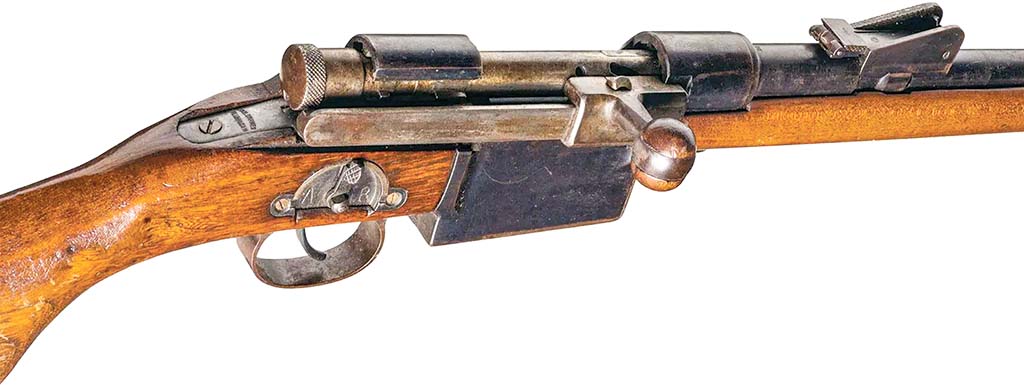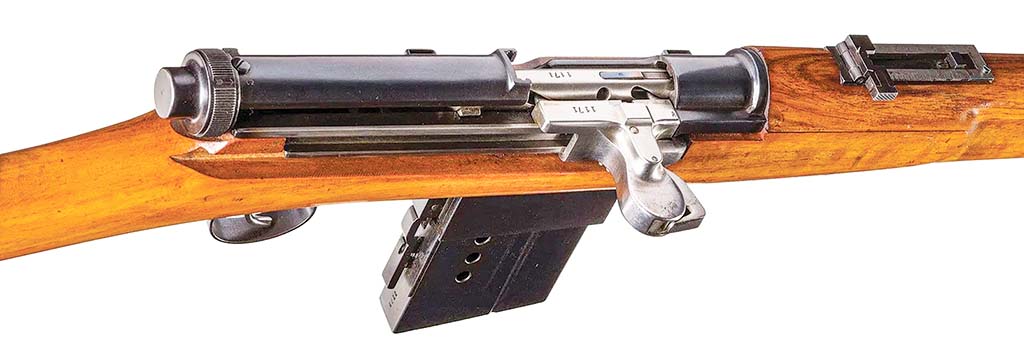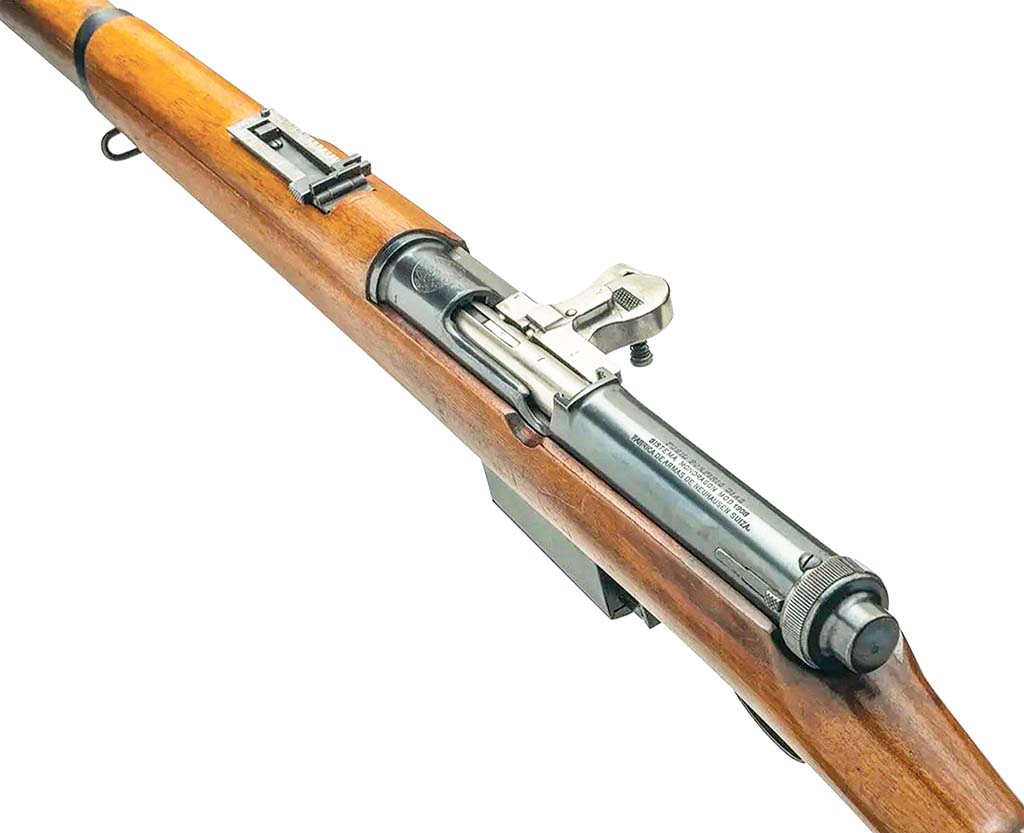By Michael Heidler –
At the beginning of the 20th century, Mexico was a country without any tradition in arms manufacturing. Interestingly enough a domestic development from Manuel Mondragón became one of the first semi-automatic rifles officially adopted by a national military.

Under the authoritarian ruling of president Porfirio Díaz from 1876 to 1911 in a period known as the Porfiriato, slow but steady industrialization of Mexico began. The country’s military was given more support, and new developments were pushed forward. Thanks to this, the officer and amateur weapons designer Manuel Mondragón experimented with improved bolt action rifles to increase their rate of fire; a path that would eventually lead him to a semi-automatic rifle. One of his early models from 1893, a straight bolt action rifle in caliber 6.5x53mm, had an unusual fire mode selector: it could be used to deactivate the trigger function so that the bolt was no longer caught by the sear. The operator then pulled the bolt back and when released, it rushed forward, feeding a cartridge from the magazine into the chamber and igniting it immediately after locking. Pressing the trigger was no longer necessary, and the operator could fire as fast as he operated the bolt.
The Mexican army took a liking to the weapon and ordered 50 pieces for a troop trial. Due to a lack of national production capacity, the weapons were manufactured at the Schweizerische Industrie-Gesellschaft SIG (Swiss Industrial Company) in Neuhausen in Switzerland, then delivered to Mexico. The first tests were successful, and in 1894 the army ordered another 200 units, this time in 5.2x68mm. This high-pressure cartridge was developed by Mondragón in collaboration with the well-known Swiss ballistics expert Colonel Eduard Rubin. Its high-speed bullet weighed only six grams and needed a small sabot (hollowed-out form) inside the cartridge case to catch the energy of the powder charge. However, the caliber did not prove itself, and Mondragón returned to working with larger calibers.




At the beginning of 1904 Mondragón finished his first semi-automatic rifle, and immediately applied for a design patent. This weapon is gas-operated with a rotating bolt. Its gas pressure escapes through a hole in the barrel into a gas tube located below the barrel and pushes a gas piston back, which in turn sets the breech in motion. A special spring-loaded coupling is integrated into the cocking handle. When the operator presses it, the bolt is released from the gas system and the weapon can be used as a straight-pull bolt action rifle. A foldable bipod was available as an additional option.

After several improvements and military demonstrations, Mondragón’s rifle in caliber 7x57mm Mauser was officially adopted in 1908 as the Fusil Porfirio Díaz Sistema Mondragón Modelo 1908. A production order for 4,000 pieces was again placed with SIG in Switzerland. According to the contract, the unit price was 160 Swiss francs, almost three times the price of a bolt-action rifle at that time.
When the first 400 weapons arrived in Mexico in 1911, an earlier prophesy from SIG proved true: the weapons showed little tolerance for contamination and reacted sensitively to fluctuating ammunition quality. This was particularly concerning as Mexico’s army could well have used good armament with the dark clouds of the Mexican Revolution gathering on the horizon. In view of the Fusil Porfirio Díaz Sistema Mondragón Modelo 1908’s unreliable function, as well as its high unit price, the government unceremoniously canceled the entire remaining order, leaving SIG with about 1,000 un-paid rifles ready for delivery.



Attempts to sell the weapons to other countries were unsuccessful, and the surplus Mondragón rifles remained in storage for the next few years. It was not until World War I that SIG was finally able to sell its old stock, namely to the German Reich. The artillery depot in Spandau near Berlin converted the Mondragón rifles to the German military standard caliber 7.92x57mm and added a detachable drum magazine, from the principle of operation similar to the one used with the pistol P08, increasing its capacity to 30 cartridges. The converted weapons were all used by the German Air Force as the “Flieger-Selbstlade-Karabiner 15” (aviator semi-automatic carbine). Only in the sky was the use of such a dirt-sensitive weapon possible at all. Nevertheless, as a precaution, each gunner was given two rifles, so as not to be defenseless in the case of a malfunction.
The Swiss had kept some of the Fusil Porfirio Díaz Sistema Mondragón Modelo 1908 rifles, converting them to their military caliber 7.5x55mm. They also added a 12-round box magazine, as well as an optional brass catcher. In the early years of the war, these rifles were used to equip reconnaissance aircraft such as the Häfeli DH-1 until enough light machine guns were available.

Technical data of the Mondragón Modelo 1908:
Caliber: 7x57mm Mauser
Length: 43.5in 1,105 mm
Length of barrel: 22.7in 577 mm
Weight (empty): 9.2lb 4.18 kg
Magazine capacity: 10 rounds

Manuel Mondragón (1859 – 1922)
The Mexican Manuel Mondragón is considered one of the pioneers in the field of semi-automatic rifles. During his eventful career in the military, he was mainly involved with artillery armament, but he became known worldwide through his Fusil Porfirio Díaz Sistema Mondragón Modelo 1908. Mon-dragón was born in 1859 in the Municipio Ixtlahuaca in the Mexican state of Méx-ico. After school, he attended the military academy in Chapultepec and left it as an artillery officer in 1880. He had always been very interested in the technology of weapons and so he designed the 75mm field gun model Saint-Chamond-Mon-dragón together with Émile Rimailho. It was manufactured by the French com-pany Compagnie des Forges et Aciéries de la Marine et d’Homécourt (FAMH) in Saint-Chamond in France. Apart from Mexico, the gun was also adopted by other countries and was even installed in tanks in France during World War I. Mondragón also wrote military instructions and training books. In 1907, under President Porfirio Díaz, he was appointed Chief of the Artillery Division.
The following year, the army introduced his 7x57mm Mauser caliber semi-automatic rifle and had it manufactured in Switzerland by SIG. He also wrote an important work on coastal defense and many South American defense installations are based on his findings. Mon-dragón did not remain inactive politically either. He actively supported the military coup in February 1913 to overthrow President Francisco I. Madero and was subsequently appointed Minister of War under the new ruler José Victoriano Huerta in gratitude. However, he retained the post only a few months before he had to resign under pressure from prominent politicians who accused him of incompetence and poor planning during the revolution. After these accusations, Huerta dropped the general and exiled him from Mexico. Mondragón traveled to Spain. In recognition of his services, he was awarded, among other things, the highest deco-oration in France, the Legion of Honor. General Manuel Mondragón died in San Sebastián in Spain in 1922. Incidentally, one of his eight children was the nude model, painter and poet María del Car-men Mondragón Valseca, better known by her artistic name Nahui Olín
| This article first appeared in Small Arms Review V25N4 (April 2021) |












